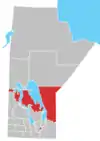Lake St. Martin First Nation (Ojibwe: Obashkodeyaang)[1] is a Canadian First Nations government and Treaty 2 signatory.
The First Nation was based primarily at Lake St. Martin about 225 kilometres (140 mi) northwest of Winnipeg until May 2011. When a massive flood hit Manitoba, the Government of Manitoba decided to divert water to Lake St. Martin in order to protect cottage, and agricultural properties on other bodies of water. [2] As a result all the housing at Lake St. Martin First Nation was destroyed. As of 2019, approximately 1,000 flood evacuees are still displaced.[3]
Reserves
- The Narrows 49 2,613.30 hectares (6,457.6 acres)
- The Narrows 49A 982 hectares (2,430 acres)
References
- ↑ Andy Thomas Thomas, Florence Paynter. The Significance of Creating First Nation Traditional Names Maps. Manitoba First Nations Education Resource Centre Inc. https://mfnerc.org/wp-content/uploads/2015/05/The-Significance-of-Creating-First-Nation-Traditional-Names-Maps.pdf Archived 2022-10-20 at the Wayback Machine
- ↑ Thompson, Shirley; Myrle Ballard; Donna Martin (2014). "Lake St. Martin First Nation Community Members' Experiences of Induced Displacement: "We're like refugees"". Refuge. 29 (2): 75–86. doi:10.25071/1920-7336.38168.
- ↑ "Deal for a new Lake St. Martin - Winnipeg Free Press". Winnipeg Free Press. Retrieved 13 November 2014.
51°44′53″N 98°26′09″W / 51.748036°N 98.43571°W
This article is issued from Wikipedia. The text is licensed under Creative Commons - Attribution - Sharealike. Additional terms may apply for the media files.
